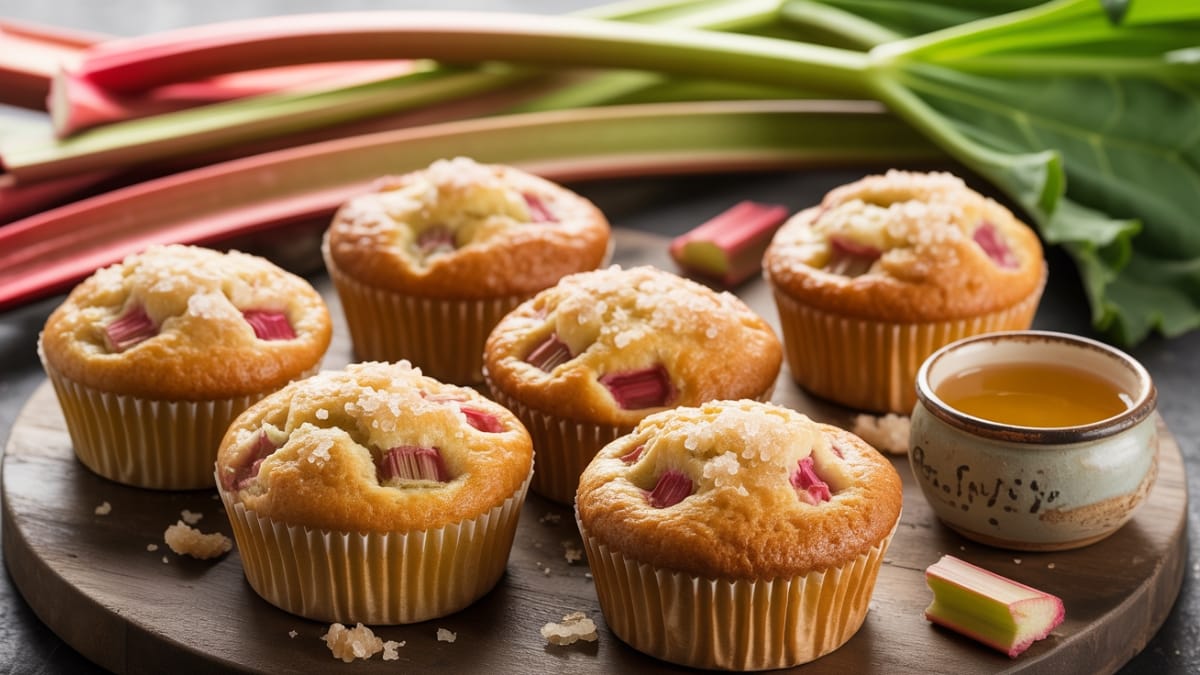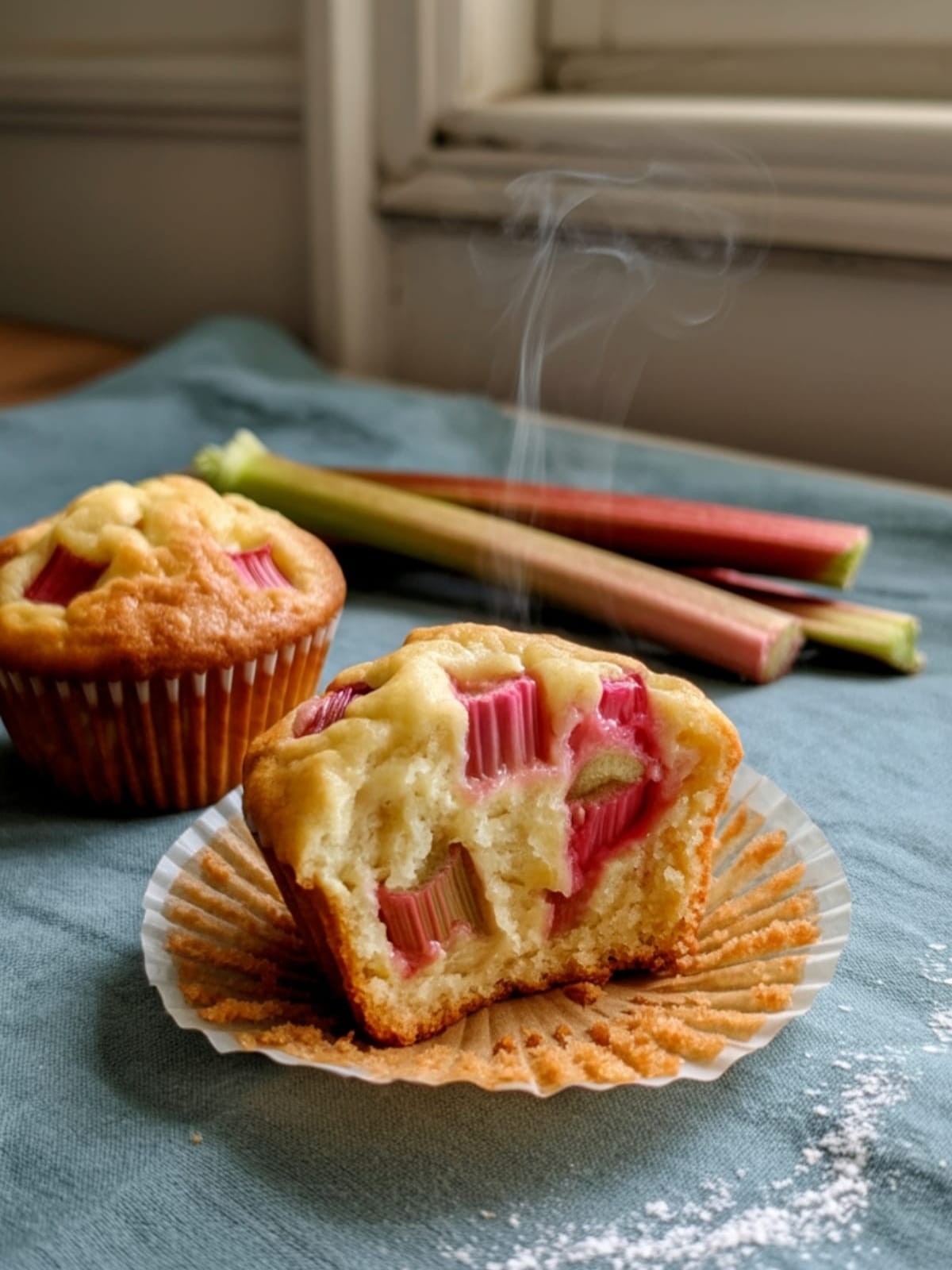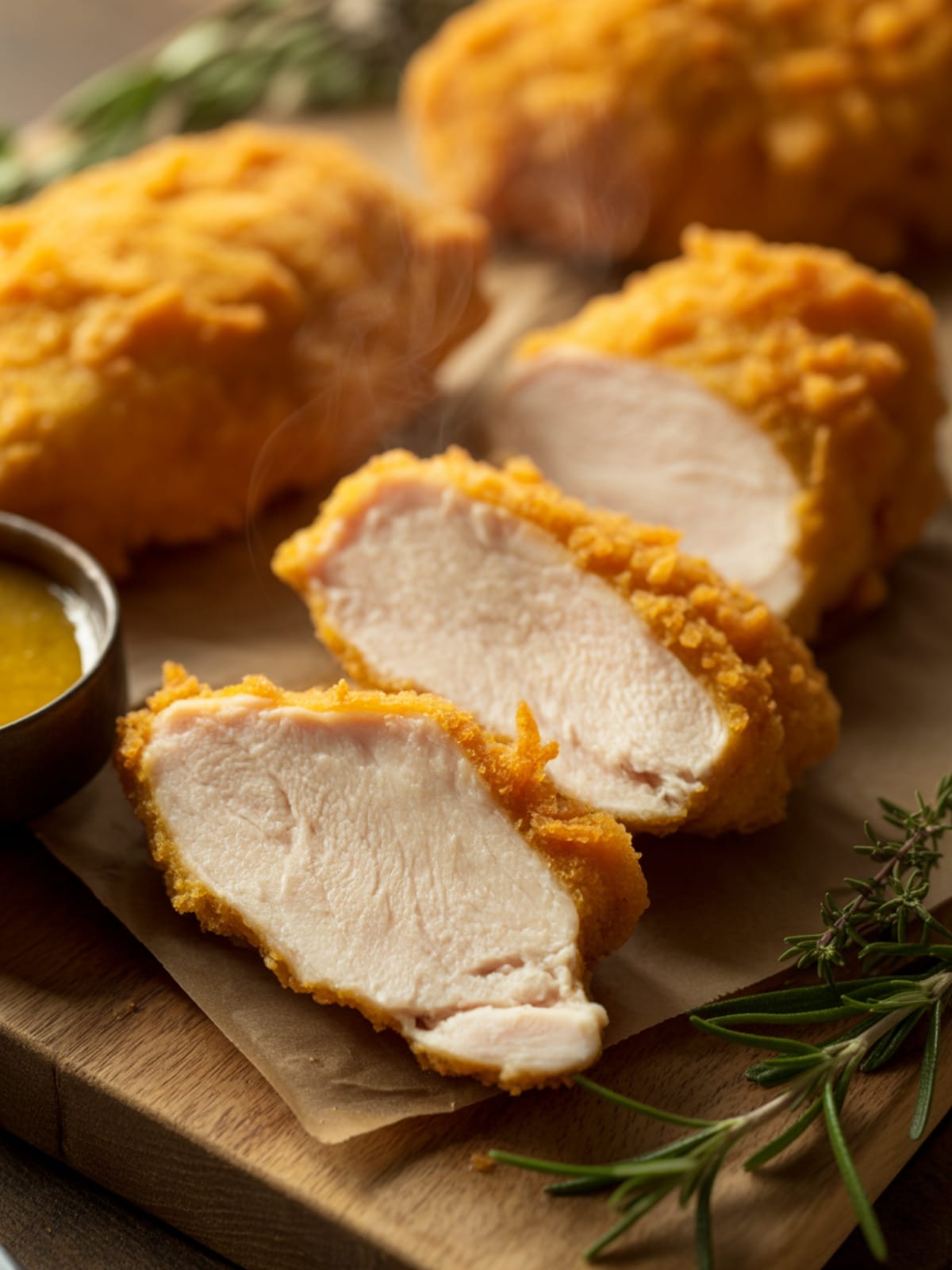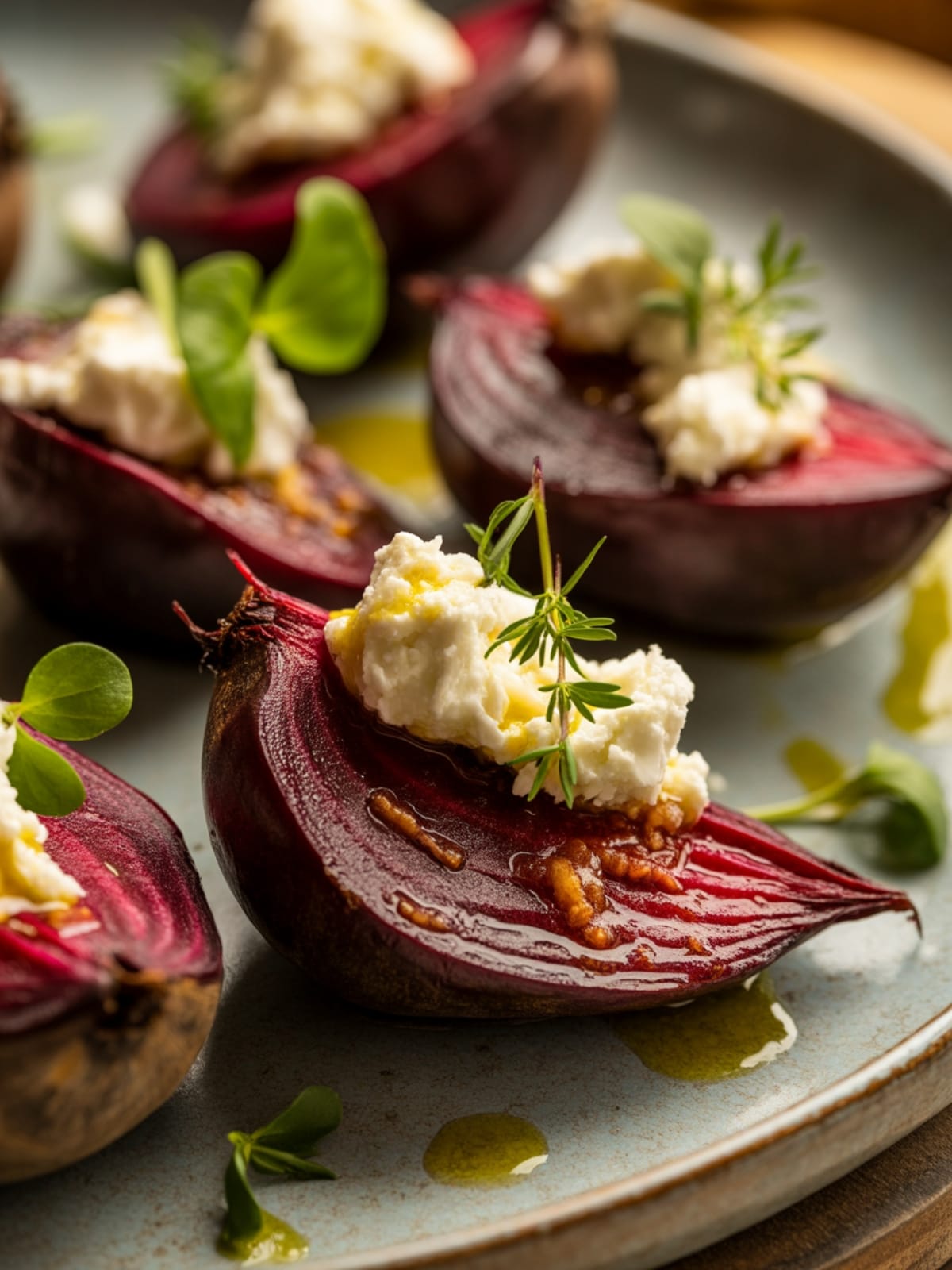Ever bitten into a muffin that perfectly balances tangy and sweet in each moist, tender crumb? That’s exactly what these Rhubarb Muffins with Greek Yogurt deliver. The ruby-red streaks of spring rhubarb create little pockets of bright flavor that wake up your taste buds, while the Greek yogurt brings a subtle tang and incredible moisture without heaviness.
These aren’t your average coffee shop muffins that disappear from memory as quickly as they do from your plate. These are the kind that prompt friends to text you three days later asking for the recipe.
Why This Recipe is Awesome

What makes these Rhubarb Muffins with Greek Yogurt stand out is their perfect balance. The Greek yogurt creates an incredibly tender crumb while reducing the need for excessive oil or butter.
Meanwhile, the rhubarb provides bursts of bright, tangy flavor that perfectly complements the subtle sweetness of the batter. Unlike many fruit muffins that can become soggy or dense, these maintain their perfect texture even the next day (if they last that long!). The recipe is also incredibly versatile—it works beautifully with frozen rhubarb in winter months when fresh isn’t available.
As someone who’s tested countless muffin recipes, I can confidently say the yogurt-to-flour ratio here creates that elusive bakery-style dome that home bakers often struggle to achieve. Plus, they freeze beautifully for quick breakfasts or afternoon treats whenever a craving strikes.
Equipment needed: Muffin tin, paper liners, mixing bowls, measuring cups, spoons, whisk, rubber spatula

Rhubarb Muffins with Greek Yogurt
Ingredients
- 2 cups all-purpose flour
- 3/4 cup granulated sugar
- 2 teaspoons baking powder
- 1/2 teaspoon baking soda
- 1/4 teaspoon salt
- 1 cup plain Greek yogurt full-fat provides best texture
- 2 large eggs room temperature
- 1/3 cup vegetable oil
- 1 teaspoon vanilla extract
- 1 1/2 cups fresh rhubarb diced into 1/4-inch pieces (or frozen, thawed and drained)
- Zest of one lemon optional but recommended
- 2 tablespoons coarse sugar for topping turbinado or demerara work best
Instructions
- Preheat your oven to 375°F (190°C) and line a 12-cup muffin tin with paper liners or grease well with cooking spray.
- Combine all dry ingredients in a large bowl – whisk together the flour, sugar, baking powder, baking soda, and salt until well mixed.
- Mix the wet ingredients in a separate medium bowl – thoroughly whisk the Greek yogurt, eggs, oil, and vanilla extract until smooth and no yogurt lumps remain.
- Pour the wet mixture into the dry ingredients and fold gently with a rubber spatula just until combined. The batter should be thick and not completely smooth – overmixing will create tough muffins.
- Gently fold in the diced rhubarb and lemon zest with just a few strokes to distribute evenly throughout the batter.
- Divide the batter evenly among the prepared muffin cups, filling each about 3/4 full for that perfect dome.
- Sprinkle the tops with coarse sugar for a delightful crunch and extra sweetness that balances the tart rhubarb.
- Bake for 18-22 minutes until the tops are golden and a toothpick inserted in the center comes out clean or with just a few moist crumbs.
- Cool in the pan for 5 minutes, then transfer to a wire rack to cool completely – though they’re absolutely divine while still warm!
Notes
- If using frozen rhubarb, thaw completely and pat dry with paper towels to remove excess moisture that could make the muffins soggy.
- The muffin batter should be thick – this helps suspend the rhubarb pieces throughout rather than letting them sink to the bottom.
- These muffins freeze beautifully for up to 3 months. Thaw overnight in the refrigerator or microwave for 20-30 seconds from frozen.
- For a flavor variation, add 1/2 cup chopped strawberries along with the rhubarb for a classic spring combination.
- The lemon zest is technically optional but adds a bright note that enhances the rhubarb’s natural tanginess.
Calories & Nutritional Info
- Calories: Approximately 220 calories per muffin
- Protein: 5g per muffin (thanks to the Greek yogurt)
- Carbohydrates: 32g per muffin
- Fat: 8g per muffin
- Fiber: 1g per muffin
- Contains: Wheat, dairy, and eggs
- Not suitable for: Vegan or gluten-free diets without modifications
Common Mistakes to Avoid
- Overmixing the batter – This develops gluten and results in tough, rubbery muffins. Mix just until the dry ingredients are moistened.
- Using cold eggs – Cold eggs don’t incorporate as well and can cause the batter to curdle. Set them out 30 minutes before baking.
- Cutting rhubarb pieces too large – Pieces larger than 1/4-inch won’t soften properly during baking and can create soggy pockets.
- Underbaking – These muffins need to reach an internal temperature of about 200°F to be fully baked. If underbaked, they’ll collapse when cooling.
- Skipping the sugar topping – Since rhubarb is quite tart, the sugar topping provides necessary sweetness balance in each bite.
Alternatives & Substitutions
- Dairy-free option: Substitute the Greek yogurt with coconut yogurt or soy yogurt, though the texture will be slightly different.
- Whole wheat version: Replace half the all-purpose flour with whole wheat flour for added nutrition (may need 1-2 tablespoons more liquid).
- Reduced sugar: Cut sugar to 1/2 cup and add 2 tablespoons of honey for natural sweetness.
- Fruit swaps: When rhubarb isn’t available, try tart apples, cranberries, or sour cherries for a similar tangy profile.
- Flavor variations: Add 1/2 teaspoon ground cardamom or ginger for a warming spice note that complements the rhubarb beautifully.
- Oil alternatives: Melted butter can replace the oil for a richer flavor, though the texture will be slightly less moist.
FAQs
Do I need to peel rhubarb before adding it to muffins?
No, peeling isn’t necessary for most rhubarb, especially the younger, tender stalks. Just wash thoroughly, trim the ends, and remove any stringy fibers by pulling them down the stalk as you would with celery. If your rhubarb is particularly thick or tough, a light peeling might improve the texture.
Can I use strawberry Greek yogurt instead of plain?
Absolutely! Using strawberry Greek yogurt adds a complementary flavor that pairs beautifully with rhubarb. If using flavored yogurt, reduce the sugar by 2-3 tablespoons since the yogurt already contains sweetener.
Why did my rhubarb sink to the bottom of the muffins?
This typically happens when the batter is too thin or the rhubarb pieces are too large and heavy. Make sure your batter is properly thick (it should scoop, not pour) and that your rhubarb is cut into small, even pieces. Tossing the rhubarb in a tablespoon of the flour mixture before adding can also help prevent sinking.
How can I tell when the muffins are perfectly done?
The tops should be golden brown and spring back when lightly touched. A toothpick inserted into the center should come out clean or with a few moist crumbs, but no wet batter. The internal temperature should reach about 200°F (93°C) when measured with an instant-read thermometer.
Can I make these muffins ahead for a brunch party?
These muffins actually taste even better the day after baking as the flavors meld. Bake them the evening before, cool completely, and store in an airtight container at room temperature. For the freshest taste, you can reheat them for 10 seconds in the microwave just before serving.
Final Thoughts
These Rhubarb Muffins with Greek Yogurt are more than just a recipe—they’re a celebration of spring’s most underappreciated vegetable in its most delicious form. The bright tang of rhubarb against the tender, yogurt-enriched crumb creates something truly special that’ll have you looking forward to rhubarb season all year long. So grab those ruby stalks next time you see them and treat yourself to these little bites of spring sunshine.






